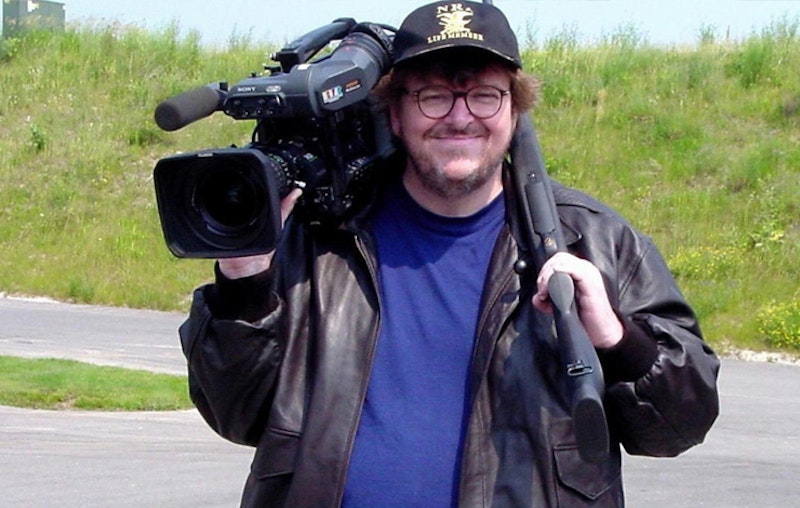Michael Moore deserves credit for making documentaries marketable in the United States, whether or not you think his movies are any good. I really liked Bowling for Columbine and Fahrenheit 9/11 when they came out in 2002 and 2004, respectively, but, without meaning to, I haven’t seen anything from him since. I waited for Sicko, but the movie was poorly distributed and if it made it to Baltimore, maybe only for a week; his schtick was exhausted by 2009’s Capitalism: A Love Story. For whatever reason, I often think a night in the spring of 2016, sitting at a sushi bar with my girlfriend at the time, waiting for the downpour outside to stop so we could drive to see Where to Invade Next? (We never made it.)
Moore, like most media figures new and old, was rejuvenated by the election of Donald Trump, and once again, credit due for his correct call on the election that year. I haven’t followed or caught up with Moore or his work since—he’s still a childhood enthusiasm, not a documentarian, but the only American cinematic equivalent of an opinion columnist. Frederick Wiseman, the best maker of documentary films to ever live, has dismissed Moore—“not a documentary filmmaker”—and like many, rightly criticized Moore’s many omissions, distortions, manipulations, and lies in his films about “real life.”
Revisiting Bowling for Columbine, what struck me was both how accomplished it was as a film and an argument. Bowling for Columbine isn’t about the Columbine shootings, or Eric Harris and Dylan Klebold, but the violence that undergirds our country. In this way, it’s similar to The Shining, Stanley Kubrick’s mosaic of American atrocities rather than his confession to faking the moon landing; it’s also not a film that bothers me nearly as much as it has in the last 15 or so years. Moore’s two big hits in the early-2000s wouldn’t have made as much money as they did if they weren’t so entertaining. Mel Gibson could make a vile movie like The Passion of the Christ and sell out theaters, but he had Jesus on his side—“good liberals” will, or would, only go so far with their cultural “vegetables.”
But far more people love Terminator 2 than The Passion of the Christ—a good Christian gets behind the apocalypse. Moore’s film hasn’t dated at all; in fact, it’s become richer and clearer 20 years later. Throughout the 2000s and into the Trump years, Moore was beating a dead horse. He had his town halls in Michigan. He made movies every two or three years. None of them got the kind of press or distribution that Bowling for Columbine and Fahrenheit 9/11 enjoyed. I never imagined I’d be curious about his work again, but it’s remarkable how Bowling for Columbine has been distilled, a film so much easier to see now that the 2000s are history. Moore’s narcissism, along with his dishonest use of a cartoon in the style of South Park about 20 minutes after an interview with that show’s co-creator, Matt Stone remain galling: he asked Stone and Trey Parker if they would contribute to his film, and they declined; instead, Moore hired someone else to essentially remake one of Parker’s student films, American History.
There are many more insults like that in the film that haven’t been talked about or discovered at all, but its thesis—that Americans are uniquely violent because of a culture of fear—sustains a diverse narrative thread for two hours, and is obvious today. Moore was making his film when Midwesterners were buying guns and gas masks to protect themselves against the Taliban, and while he includes a brief news clip about post-9/11 home defense shopping, he doesn’t mock poor people, implicitly or explicitly, unlike so many other filmmakers here and abroad.
The closest thing to an answer in Bowling for Columbine is Charlton Heston’s climactic interview, where he slips up and muses that America’s problem with violence has to do with its “mixed ethnicity… we had enough problems with civil rights, so…” Moore correctly points out throughout the film that white people are the ones buying guns and gas masks and moving to the suburbs. These conclusions are obvious and perhaps well-worn by now, but not fully understood, because so much “anti-racist” media made in the last three years were naked cash grabs that hurt more than helped. Bowling for Columbine is entertaining but it’s still a brutal movie, one whose indictments pile up and make you feel unclean, certainly now—it’s a film that couldn’t be made today because it confronts the viewer and aims to make them uncomfortable and irritated. Most importantly, it conveys a nugget of truth about our country, not like Wiseman, but far more than any so-called “woke” movie today.
—Follow Nicky Smith on Twitter: @nickyotissmith

